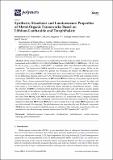Por favor, use este identificador para citar o enlazar a este item:
http://hdl.handle.net/10261/149201COMPARTIR / EXPORTAR:
 SHARE SHARE
 CORE
BASE CORE
BASE
|
|
| Visualizar otros formatos: MARC | Dublin Core | RDF | ORE | MODS | METS | DIDL | DATACITE | |

| Título: | Synthesis, Structures and Luminescence Properties of Metal-Organic Frameworks Based on Lithium-Lanthanide and Terephthalate |
Autor: | Abdelbaky, Mohammed S. M.; Amghouz, Zakariae CSIC ORCID; García-Granda, Santiago CSIC ORCID ; García, José R. CSIC ORCID | Fecha de publicación: | 16-mar-2016 | Editor: | Multidisciplinary Digital Publishing Institute | Citación: | Polymers 8 (3): 86 (2016) | Resumen: | Metal-organic frameworks assembled from Ln(III), Li(I) and rigid dicarboxylate ligand, formulated as [LiLn(BDC)<sub>2</sub>(H<sub>2</sub>O)·2(H<sub>2</sub>O)] (MS1-6,7a) and [LiTb(BDC)<sub>2</sub>] (MS7b) (Ln = Tb, Dy, Ho, Er, Yb, Y<sub>0.96</sub>Eu<sub>0.04</sub>, Y<sub>0.93</sub>Tb<sub>0.07</sub>, and H<sub>2</sub>BDC = terephthalic acid), were obtained under hydrothermal conditions. The isostructural MS1-6 crystallize in monoclinic <i>P</i>2<sub>1</sub>/c space group. While, in the case of Tb<sup>3+</sup> a mixture of at least two phases was obtained, the former one (MS7a) and a new monoclinic <i>C</i>2/c phase (MS7b). All compounds have been studied by single-crystal and powder X-ray diffraction, thermal analyses (TGA), vibrational spectroscopy (FTIR), and scanning electron microscopy (SEM-EDX). The structures of MS1-6 and MS7a are built up of inorganic-organic hybrid chains. These chains constructed from unusual four-membered rings, are formed by edge- and vertex-shared {LnO<sub>8</sub>} and {LiO<sub>4</sub>} polyhedra through oxygen atoms O3 (vertex) and O6-O7 (edge). Each chain is cross-linked to six neighboring chains through six terephthalate bridges. While, the structure of MS7b is constructed from double inorganic chains, and each chain is, in turn, related symmetrically to the adjacent one through the <i>c</i> glide plane. These chains are formed by infinitely alternating {LiO<sub>4</sub>} and {TbO<sub>8</sub>} polyhedra through (O2-O3) edges to create Tb–O–Li connectivity along the <i>c</i>-axis. Both MS1-6,7a and MS7b structures possess a 3D framework with 1D trigonal channels running along the <i>a</i> and <i>c</i> axes, containing water molecules and anhydrous, respectively. Topological studies revealed that MS1-6 and MS7a have a new 2-nodal 3,10-c net, while MS7b generates a 3D net with unusual β-Sn topology. The photoluminescence properties Eu- and Tb-doped compounds (MS5-6) are also investigated, exhibiting strong red and green light emissions, respectively, which are attributed to the efficient energy transfer process from the BDC ligand to Eu<sup>3+</sup> and Tb<sup>3+</sup>. | Versión del editor: | http://doi.org/10.3390/polym8030086 | URI: | http://hdl.handle.net/10261/149201 | DOI: | 10.3390/polym8030086 | Identificadores: | doi: 10.3390/polym8030086 |
| Aparece en las colecciones: | (CINN) Artículos |
Ficheros en este ítem:
| Fichero | Descripción | Tamaño | Formato | |
|---|---|---|---|---|
| polymers-08-00086.pdf | 4,89 MB | Adobe PDF |  Visualizar/Abrir |
CORE Recommender
PubMed Central
Citations
1
checked on 08-mar-2024
SCOPUSTM
Citations
12
checked on 16-abr-2024
WEB OF SCIENCETM
Citations
11
checked on 23-feb-2024
Page view(s)
310
checked on 23-abr-2024
Download(s)
398
checked on 23-abr-2024

